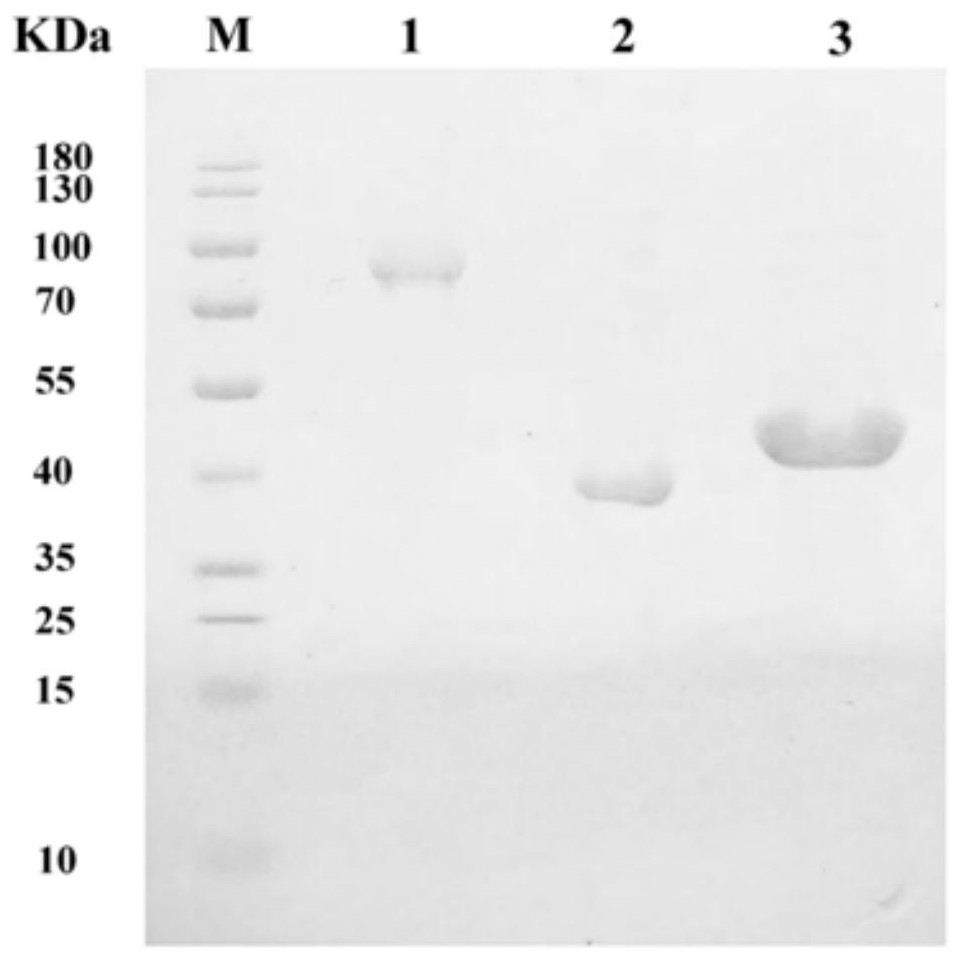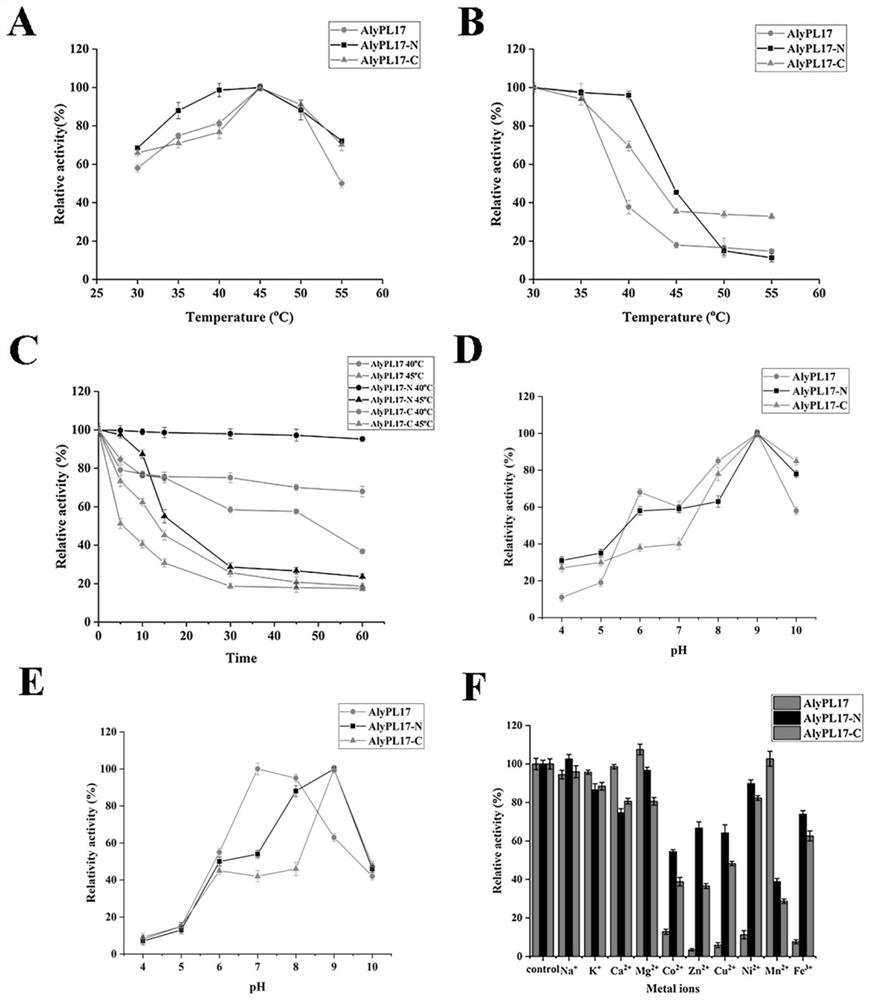Alginate lyase AlyPL17, truncation and application of alginate lyase AlyPL17 and truncation
A technology of alginate lyase and alypl17-c, which is applied in the field of genetic engineering technology and protein expression, can solve the problems of limiting alginate bioenergy conversion and achieve high specific activity
- Summary
- Abstract
- Description
- Claims
- Application Information
AI Technical Summary
Method used
Image
Examples
Embodiment 1
[0027] Example 1: Culture and Genome Extraction of Pedobacter hainanensis NJ-02.
[0028] The alginate lyase AlyPL17 involved in the present invention is derived from bacterial strain Pedobacter hainanensis NJ-02, and the preservation number of the adopted bacterial strain Pedobacter hainanensis NJ-02 is CCTCCM2016579 (the strain information is disclosed in B.Zhu, et al., Int.J. Biol. Macromol. (2017)). After uploading the sequence of AlyPL17 to the NCBI database for sequence comparison, it can be seen that AlyPL17 has a high sequence identity with the PL17 family alginate lyase, for example, the sequence identity of AlyPL17 and Alg17c from Saccharophagus degradans 2-40 is 44%, The sequence identity with AlgL derived from Sphingomonas sp.MJ-3 reached 43%. It indicated that AlyPL17 is a novel PL17 family alginate lyase.
[0029] The formulation of the culture medium used is:
[0030] LB medium: tryptone 10g, yeast extract 5g, NaCl 10g, pH7.0. Solid medium supplemented with ...
Embodiment 2
[0032] Spread the preserved strains on the solid selection medium, and cultivate the activated colonies in the liquid selection medium. Take 4mL of the cultured bacterial solution, put it in a 2mL tube, centrifuge at 5000g for 10min. Discard the supernatant, resuspend the bacteria with 180 μL of digestion solution (Digestion Solution), then add 20 μL of proteinase K, mix well, and incubate at 56°C for 30 min. Add 20 μL of RNaseA, mix thoroughly, and place at room temperature for 10 minutes. Add 200 μL of Lysis Solution and mix quickly, the process should not exceed 15s. Add 400 μL of 50% (v / v) ethanol solution and mix well. Transfer the above solution to an adsorption column, let it stand for 1min, centrifuge at 6000g for 1min, discard the waste liquid, and transfer the adsorption column to a new 2mL tube. Add 500μL wash buffer I, centrifuge at 8000g for 1min, and discard the waste liquid. Add 500μL wash buffer II, centrifuge at 8000g for 1min, and discard the waste liquid...
Embodiment 3
[0044] Example 3: Construction of recombinant expression vectors of alginate lyase AlyPL17 and its truncations AlyPL17-N and AlyPL17-C and corresponding expression and purification.
[0045] Design primers according to AlyPL17:
[0046] Forward primer: 5'-ATGAGCGCGCAGAGCCAT-3'
[0047] Reverse primer: 5'-TTTGCCGCTTTCCACTTTCA-3'.
[0048] The following amplification primers were designed according to the sequence of AlyPL17-N:
[0049] Forward primer: 5'-ATGAGCGCGCAGAGCCAT-3'
[0050] Reverse primer: 5'-CGCTTTGTTATCCGCCAGAT-3'.
[0051] The following amplification primers were designed according to the sequence of AlyPL17-C:
[0052] Forward primer: 5'-GAACCGTTTAAATATCGCAGCC-3'
[0053] Reverse primer: 5'-TTTGCCGCTTTCCACTTTCA-3'.
[0054] Perform PCR amplification to obtain the full-length sequences of AlyPL17, AlyPL17-N and AlyPL17-C genes. The PCR conditions were: pre-denaturation at 94°C for 3 minutes, followed by 30 cycles of 94°C for 30s, 55°C for 30s, and 72°C for ...
PUM
 Login to View More
Login to View More Abstract
Description
Claims
Application Information
 Login to View More
Login to View More - R&D
- Intellectual Property
- Life Sciences
- Materials
- Tech Scout
- Unparalleled Data Quality
- Higher Quality Content
- 60% Fewer Hallucinations
Browse by: Latest US Patents, China's latest patents, Technical Efficacy Thesaurus, Application Domain, Technology Topic, Popular Technical Reports.
© 2025 PatSnap. All rights reserved.Legal|Privacy policy|Modern Slavery Act Transparency Statement|Sitemap|About US| Contact US: help@patsnap.com



